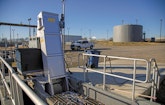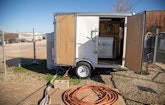
Town of Muldrow (Oklahoma) wastewater operator Josh Randolph adjusts the Digester Skimmer at the wastewater treatment facility in Muldrow. (Photography by David McNeese)
Interested in Cleaning?
Get Cleaning articles, news and videos right in your inbox! Sign up now.
Cleaning + Get AlertsThe small town of Muldrow, Oklahoma, population 3,200, is efficiently managed by a lean crew. Over the years, they have taken an old-school approach to managing their sewer collections system, treatment plant and water systems, but new technology is helping them stay ahead of the community’s needs.
The town of Muldrow’s utilities formed to serve the region’s water needs and in 1935 its first tax was imposed on residents to enable the addition of water services for the community. A decade later the construction of the current sewer collections system was completed. It comprises 12.5 miles of mainlines, five lift stations and 388 manholes. Pipelines are primarily vitrified clay pipe with diameters ranging from 6 to 14 inches. The topography of the area is hilly, so the system is primarily gravity-based.
“Based on the region and the construction practices available at the time, the system we have is pretty impressive and the lines were extremely well laid, and considering their age are in fairly good health,” says town administrator Matthew Duke.
The town’s original sewer system was installed in 1946, replacing a lagoon system. Upgrades were performed in the 1980s to create a mechanical treatment facility with digesters, sand beds for drying sludge and one clarifier. In 1993 an additional clarifier was added, followed by an aeration basin. In 2010, another round of upgrades added a second aeration basin and digester along with sludge dewatering so that the biosolids could be hauled off to a local landfill. This $6 million improvement gave the plant a capacity of 0.65 mgd and it processes on average 0.42 mgd daily.
Finding the financial wherewithal to perform upgrades or add equipment can be a challenge for such a small community, but Duke and his team are resourceful and take advantage of grants available through the state OMAG program to procure needed tools and items to keep their systems healthy.
Over the years one of the biggest challenges Muldrow faced was rags and wipes constantly coming through the lines and creating backups at the plant. This forced the operations team to add more maintenance calls for line jetting, cleaning and clearing pump stations. It also required the plant’s pumps and aerators to run at higher speeds, which raised energy costs. The addition of a bar screen from EnviroCare at the headworks helped tremendously and since its installation, the problematic debris is being caught before it can enter the treatment facility.
All in-house
Surprisingly, the small Muldrow crew is able to perform all its collections system preventive maintenance and inspection entirely in-house. The fleet includes a PipeHunter jetter unit that is skid-mounted onto the back of a 2-ton pickup and a small CCTV inspection system from Gen-Eye. There is a tremendous amount of departmental cross-training for the sewer plant operator, water plant operator, utility worker, special projects manager, utility director and the city administrator. All are certified or trained to perform each other’s jobs.
“We do not have a dedicated inspection crew or pipeline cleaning crew. Whoever is available for the day and not assigned to another project is usually the one performing the tasks,” Duke explains. “All of us carry multiple licenses so we have the ability to help each other out whenever one of us is having a specific issue in our department.”
Despite the availability of data collection software, Muldrow is still effectively performing field inspections, manually taking notes on pipeline assessment and adding findings into Excel spreadsheets. They have found that by utilizing SL-RAT acoustic technology from InfoSense as a first point of assessment, they can be more efficient with their limited crew. If the SL-RAT indicates a blockage or some other issue, they will deploy their sewer camera into the line. To date they have inspected the entire collections system utilizing this approach.
“Incorporating the SL-RAT for assessing our whole collections system, which is fairly spread out, was an enlightening moment for everybody within our staff. It enabled us to get out in the field, pop manholes, investigate them quickly and see all of the problems that we had throughout the collections system,” Duke says. “It showed us that in some areas the system was not in as decent shape as the town imagined.
“Although finding situations like this can be overwhelming for a utility director, the nice thing is that it allows you to get a game plan set so that you can start chipping away at your issues and get back to where your system is in a healthy condition again,” he says. “The trick is not to ignore it and to keep going out there and looking at your collections system. Although it is one of the toughest things to do for small community, you need to go and look for the problems whether you think you have those problems or not.”
Muldrow experienced a little windfall recently regarding the assessment of its collections system through the work of the local gas utility, which was installing a new delivery system through a significant portion of the community. This required that Muldrow’s existing infrastructure in the new construction area be inspected to map locations of buried utilities and pinpoint any existing cross bores, as well as prevent new cross bores from happening. The gas utility jetted and inspected 70% of Muldrow’s collections system and generously shared a copy of the footage with the city.
Luckier than most
Muldrow is fortunate in that it has been able to cost-effectively use traditional dig-and-replace methods for aging and failing pipes, but the use of trenchless methods isn’t off the table.
“We do have some areas that are older that we suspect will have the potential for us to go a trenchless route, as they go under creeks and are located in difficult access areas. So when the need arises, we will certainly be looking at incorporating these remote methods if it makes sense,” Duke says.
New approach
Muldrow’s retention ponds at the treatment plant were holding approximately 7 feet of sludge, which was becoming problematic during rain events as the ponds were over 60% of total capacity. While proactively looking for a solution, Duke was introduced to a new disruptive technology from EnBiorganic Technologies and was offered a free, no-risk performance trial of a new proprietary patent-pending system that could start reducing sludge content in the retention ponds in a noticeably short period of time.
Muldrow agreed to try it and the EnBiorganic Technologies EBS-Di unit was installed in one of Muldrow’s lift stations approximately 2 1/2 miles upstream from the treatment plant. The EBS-Di autonomously delivers a controlled, monitored consortium of customized active soil bacteria into the system that is hungry and ready to enjoy the “food” available in a particular system’s wastewater stream.
Upstream from the lift station is a food processing plant that makes breaded and marinated prepackaged chicken products. Rather than the typical byproducts associated with food processing, Muldrow was experiencing an onslaught of breading material that would enter the system when the factory performs its washdowns every shift. An oatmeal-like material would come into the system and create an unusual reaction in the wastewater stream, creating a glue-like sludge that would clog up the lift station. A special screen was installed to work in tandem with the EBS-Di system to counteract the effects of the oncoming breading material, acting like a septic tank so just clear liquids could flow through into the lift station and then be treated.
“You can definitely see the significance and difference of using active customized biology and the benefits of the dosing unit,” Duke says. “The amount of time the bugs have to culture and how rapidly they dominate the system means that you’re getting a whole lot more result from them.
“Using this unit that is nearly 2 1/2 miles upstream from the sewer plant, we are able to produce tremendous amounts of bugs that are able to regenerate and replicate so quickly. I would’ve never believed that such a small unit could produce as much as it does and have such an impact.”
Prior to the performance trial, the Muldrow team hadn’t utilized additional bioaugmentation but had attempted to fight the good fight culturing its own bacteria that occurred naturally within the system, and by adding oxygen as they could. The same food processing plant that was creating some of the maintenance issues was using bioaugmentation at their pretreatment plant, which helped but wasn’t enough to combat the substantial amounts of sludge that were building up in the retention ponds and aeration basins.
One of the biggest surprises was the effect of this upstream bioaugmentation technology on the lift station. Within five days of operation, this station that had a history of having quite a bit of FOG had none. “It’s the cleanest that the station has ever looked, and we’re finding that we’re also having quite a few less blockages in our mainlines downstream in that 2 1/2 miles from the lift station to the plant than we’ve ever had before,” Duke says.
One of the common benefits from the technology is that by changing the wastewater makeup, less aeration is required at the treatment plant, saving energy and expense. It is hoped that over time experimenting with lower aeration levels will deliver significant savings.
The work on the reduction of the sludge in the retention ponds is now underway and showing great promise. Just like the bar screen, finding technologies that can help with maintenance, labor and wear and tear are always exciting for a small town like Muldrow, especially when given the opportunity to evaluate an innovative technology on a trial basis.
Incorporating the new technology was a big step for Muldrow.
“This was a wonderful opportunity to see what the technology could do for us because it was a leap of faith; but at the end, if it can make your systems run better and be more cost-effective, it really benefits anybody out there to give new things like this a try and experience the potential ROI for themselves.”








